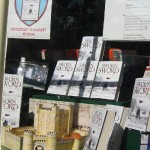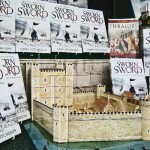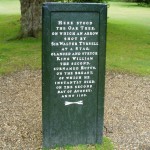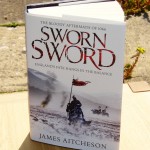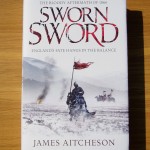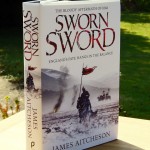August has been a busy month, with the launch of Sworn Sword followed by a string of interviews, events and signings. So far the tour has taken me from Cambridge to London, the Cotswolds, Marlborough and Salisbury – and that’s just the beginning. Here’s a selection of the latest photos:
-

- A stack of Sworn Swords, signed, lined, dated and ready to go on the shelves at Goldsboro Books in London.
Many thanks to my hosts for these events: to the friendly folks at the Cotswold Bookstore in Moreton-in-Marsh, Gloucestershire, for not only providing freshly baked honey cakes but also creating the wonderful window display seen above, complete with medieval castle. Check out their blog for details of future signings, including one with Panama Oxridge, author of the ingenious novel Justin Thyme.
Especial thanks also to the White Horse Bookshop in Marlborough, Wiltshire, who last week put on a fantastic and well attended evening signing session and supplied both customers and author with wine. They’ll be supporting the Marlborough LitFest, where I’ll be appearing as part of the Wiltshire Writers panel on Friday 23 September.
For further news of signings, talks, readings and festival appearances, take a look at my Events page. More dates are being added all the time.
The latest addition to the list is a talk at the Durham Book Festival on Friday 21 October. Returning to the place where Sworn Sword – and Tancred’s journey – begins, I’ll be speaking about the novel’s connection to the city and more generally about my inspiration for the series, and what particularly fascinates me about the Norman Conquest.
Just off the A31 between Ringwood and Southampton, in an otherwise unremarkable spot in a clearing on the edge of the New Forest, lies the supposed site of a key moment in post-Conquest English history. On 2 August 1100, King William II (known to posterity as “Rufus” on account of his ruddy complexion) was killed in what is commonly regarded as a hunting accident whilst in the company of his noblemen, including a certain Walter Tirel, who while shooting at a stag somehow found the king’s chest, piercing his lungs and killing him instantly.
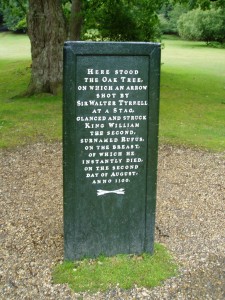
The Rufus Stone, in the New Forest
“… [A]s [Tirel] found [the king] senseless and speechless he leapt swiftly upon his horse, and escaped by spurring him to his utmost speed. Indeed there was none to pursue him, some conniving at his flight, others pitying him, and all intent on other matters. Some began to fortify their dwellings, others to plunder, and the rest to look out for a new king.”
Further fanning the flames of conspiracy theorists is the fact that the king’s younger brother Henry was also among the nobles hunting that day. On hearing of William’s death he rushed to Winchester, where the royal treasury was kept, and was crowned there within days as King of England. Did he, as many have suggested, have a hand in the killing? There is no direct evidence for it, but it cannot be ruled out conclusively.
Nowadays, the Rufus Stone marks the location where William was supposedly slain, though its claims have to be taken with a great deal of caution, since it was not identified as such until the eighteenth century. Indeed, the modern visitor can no longer see the original marker, and the green-painted cast iron “stone” which now stands on the site was erected in 1841 as a result of the first monument “having been much mutilated and the inscriptions on each of its three sides defaced”.
Regardless of the veracity of its claims, the Stone nevertheless serves as a worthwhile reminder of a significant event in English medieval history: one that may yet form the inspiration for a future novel…
The first advance copies of the Sworn Sword hardback came back from the printers this weekend and are looking terrific. Thanks to all those at Preface Publishing who have helped to make this book happen, as well as to the cover illustrator Tim Byrne, whose design graces the jacket. I fell in love with the proposed cover from the moment it was first presented to me, and it’s turned out brilliantly.
So, after months of painstaking preparation and seemingly endless edits, and consultation on everything from the jacket copy down to the typeface itself, the finished product is finally here: no fewer than 416 bound pages, with the most striking, atmospheric and dramatic cover you will see on bookshelves this summer – even if I do say so myself.
With just one month to go until publication, then, here’s a sneak preview:
[Click on the thumbnails to view the images in higher resolution.]
Listeners to this morning’s edition of In Our Time on BBC Radio 4 were treated to a fascinating discussion about the Battle of Stamford Bridge, which took place close to the city of York on 25 September 1066. This encounter saw the famed Norwegian adventurer and warrior King Harald Hardrada pitched against the newly crowned King of England, Harold Godwineson, and were it not for what happened less than three weeks later at Hastings, it would probably be regarded as one of the most significant battles of the age.
Many of the specifics relating to the battle are impossible to know, such as how many men fought on either side, or even where exactly it took place: there is no village of Stamford Bridge recorded in Domesday Book, and it is probable that the name was purely descriptive, referring to a crossing-point somewhere on the River Derwent. The outcome, however, could not have been clearer, as the Norwegian forces were routed in a decisive victory for the English.
The near-contemporary Anglo-Saxon Chronicle records that Harold came upon them by surprise, although the story that the Norwegians had left their mail hauberks on their ships is harder to credit, since it originates from Snorri Sturluson’s Heimskringla saga, written more than 150 years after the event. Whatever the manner of the victory, what is known is that Harald Hardrada was killed along with the vast majority of his army, which included Harold Godwineson’s own brother Tostig. Indeed it is said that only 24 ships sailed back to Norway, out of a fleet of roughly 300 that had set out.
Of course Stamford Bridge was merely one episode in the story of 1066, but its repercussions were enormous. Even as Harold was engaged in the north, Guillaume (William) of Normandy was able to land unopposed at Pevensey on the south coast, before raiding the region in order to gather supplies for his army. At the same time he established a castle at Hastings, thus entrenching his position. If Harold wanted to drive the invader out of the kingdom, he therefore had little choice but to march south and do battle with him, at tremendous risk to himself and the kingdom. The dénouement of that story is of course well known.
It is worth noting finally that York and the region around it continued to be a battleground for years to come. The second-largest city in England at the time, it was a rich centre for trade and a vital strong-point in the north of the kingdom, making it a key target in 1069 when Eadgar Ætheling led his army against the Normans: a tale shortly to unfold when Sworn Sword is released in hardback on 4 August.
Welcome to www.jamesaitcheson.com, my official website, and to this blog, where I will be posting regularly with all the latest news about my debut novel, Sworn Sword, which is due to be released on 4 August this year.
On this blog you’ll find also information on the forthcoming sequels, details about readings, signings and other events, as well as news and views on matters historical and literary.
I plan to add more features to the site as the publication date draws nearer, so watch this this space in the coming weeks. To keep up with all the latest updates you can also sign up to my official Facebook page or follow my official Twitter feed.



